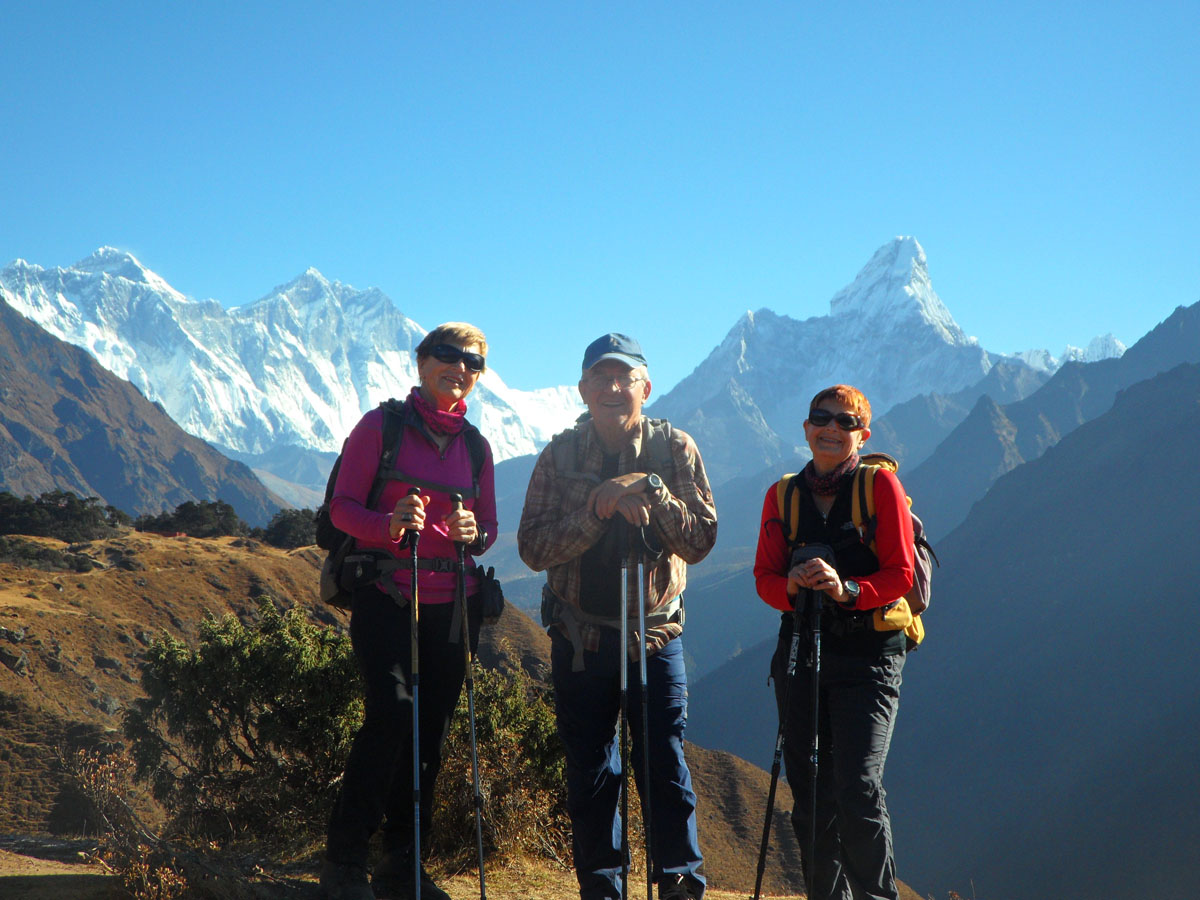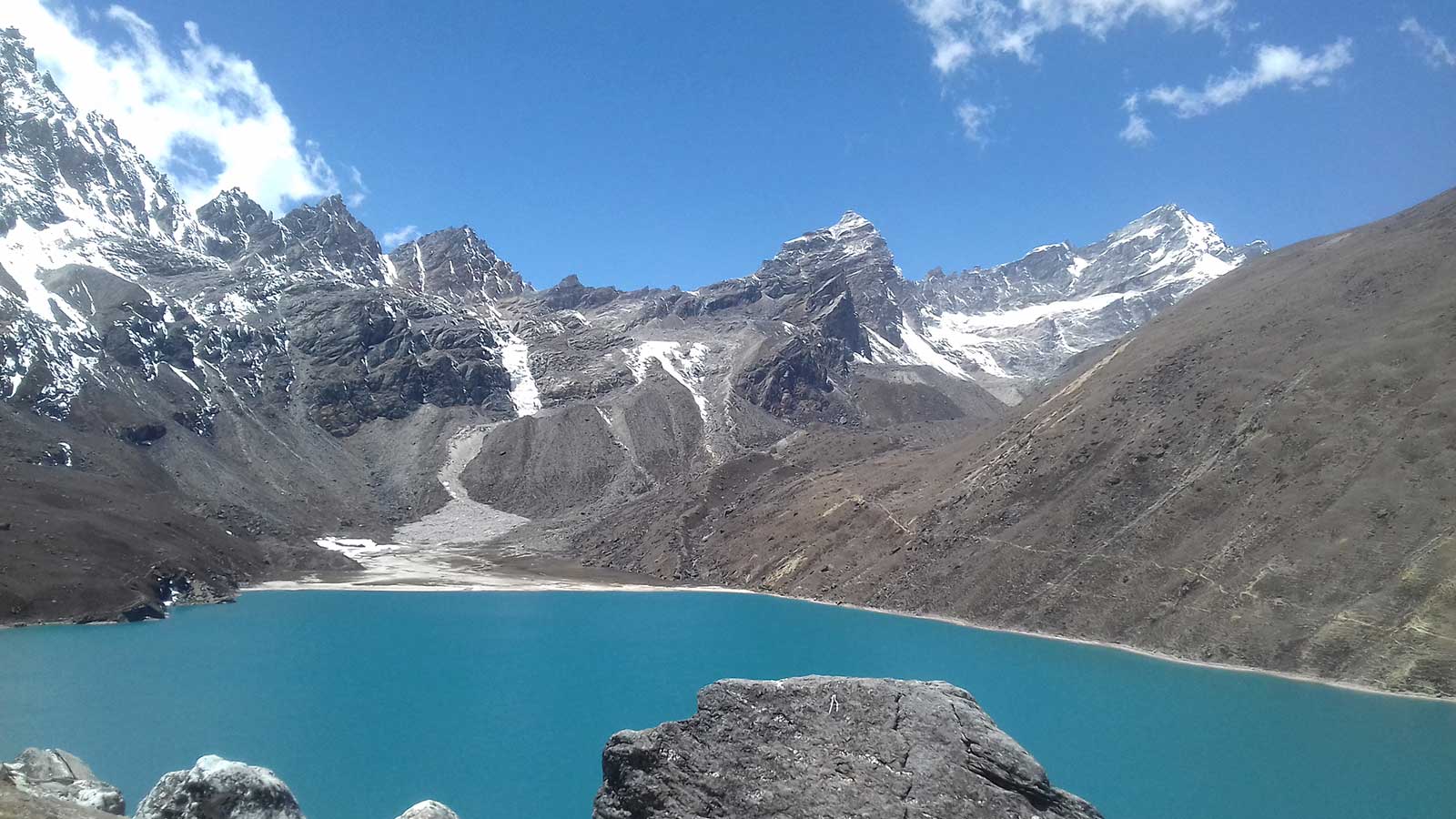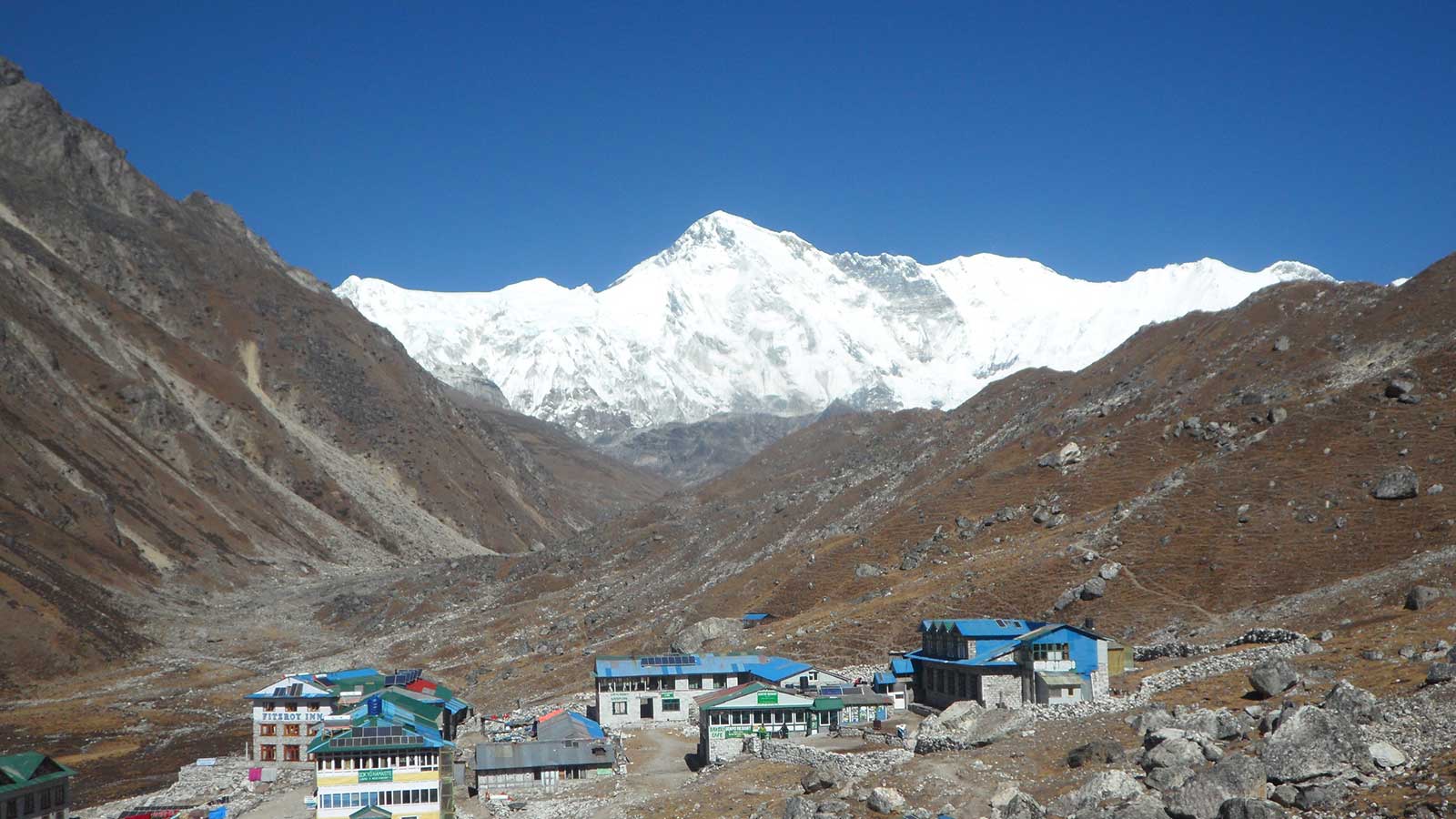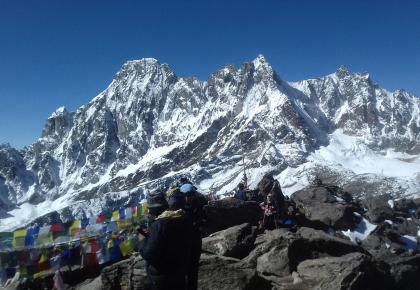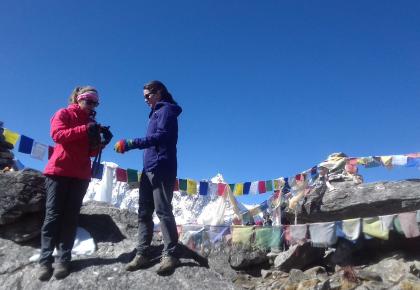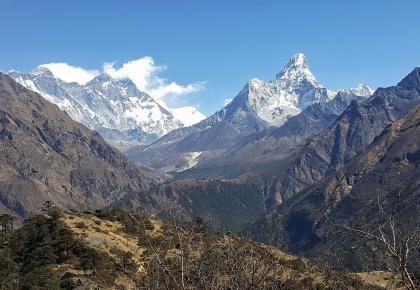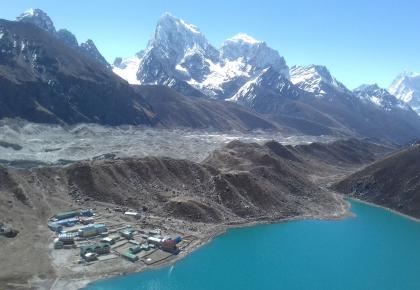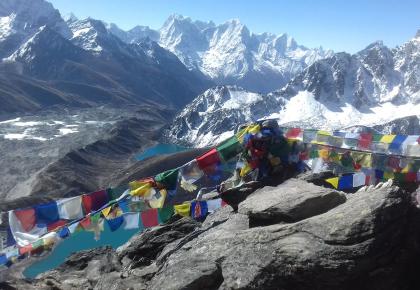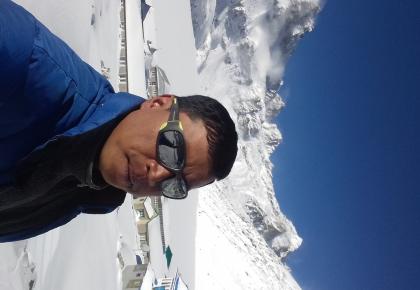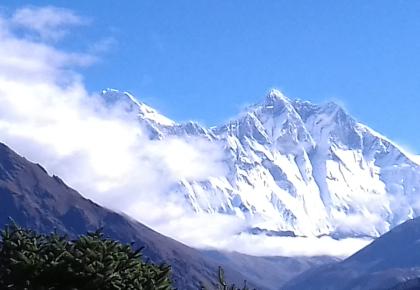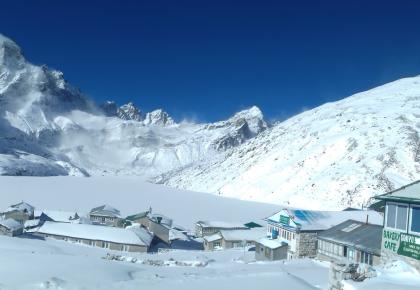Gokyo Valley Trek with Renjo La Pass
-
USD 1400
Valued At
-
15 Days
Duration
-
53800 m
Max Altitude
-
Strenuous
Trip Grade
-
2-14
Group Size
-
SEP-DEC & FEB-JUNE
Best Season
Trip Highlight
- Oppertunities to involve the respected Sherpa lifestyles in Khumbu Valley.
- Surrounded by charming mountain views from start to End from Namche.
- Impressive hike along the Dudha Koshi and Imza rivers.
- Observe the highland Sherpa culture.
- Glances of the picturesque mountains every day.
- Lovely mighty Everest view from the Everest View Lodge.
- Eye-catching Thamaserku, Ama Dablam, Lhoste, Cho Yu, and Islang peak views.
- Amazing Mt. Everest towering from Base camp.
- Breath-taking Kumbu glacier along the Khumbu Valley.
- Sightseeing in twin villages Khumjung and Khunde.
- Chance to see impressive Buddhist monasteries.
Trip Overview
For the last few years, this trek has been the choice of thousands of adventure lovers who wish to enjoy the scenery beyond mountains: lush valley, festivals, long wedding processions and many more. Also, you will be able to experience a Himalayan lifestyle with Sherpa cuisines. The main highlight of this trip is the Gokyo valley.
Gokyo valley trek offers you an opportunity to relish on the beautiful Gokyo lakes along with the picturesque view of high mountains fencing the valley. Because of the glacial floor, this lake appears turquoise in color, which makes it even more interesting to look on. As you hover around the skyline, you will witness some fluffy clouds dancing by the side of mountaintops. The overall sight is simply incredible.
This lake holds some religious beliefs as well. Hindus and Buddhists regard it as the residing place of ‘Nag Devata’, snake god. Therefore, every year, hundreds of devotees plunge their body into this divine lake during the festival of ‘Janai Purnima’, which is usually celebrated in the month of August. There is a dogma that no animals should be harmed around this region, which has paid a great deal in the conservation of fauna in the Himalayan region for hundreds of years.
The next highlight of this trip is Renjo La Pass. It offers the astounding sight of snowy giants such as Makalu, Ama Dablam, Cholatse and many other ranges including the highest peak of the world, Mt Everest. The difficulty level of this trek is moderate. So, you can take this trekking package as an alternative to Everest Base Camp (EBC) if you want to enjoy the view of snowy giants from a relatively lower elevation. Now, it is your time to venture on this remarkable journey.
Overview Itinerary
Day 1: Arrival- Pick up from Nepal airport and transfer to your hotel
Day 2: Trek Preparation and some sightseen in KTM
Day 3: Fly to Lukla 2800M-start trek to Phakding 2740M-4hours
Day 4: Phakding to Namche 3440M-6:30hours
Day 5: Namche-acclimatise days/hiking around Khumjung/khunde 3700M-Namche-5-6hours
Day 6: Namche to Phorze thanga 3530mM-5hours
Day 7: Phorze Thanga to Machermo 4430M-6hours
Day 8: Machermo-Acclimatise days/Hiking around
Day 9: Machermo to Gokyo 4700M
Day 10: Gokyo to Gokyo Ri 5380M to Gokyo 4700M-6hours
Day 11: Gokyo to Renjo La pass 5380M to Lunden 4450M-7hours
Day 12: Lunden to Namche 3440M-6hours
Day 13: Namche to Lukla 2800M-7hours
Day 14: Fly back to KTM
Day 15: Fly to your home or other activities
Day to Day Itinerary
As you land in the Tribhuvan International Airport in Kathmandu, one of our airport representatives will pick you up and escort you towards your hotel.
Because of traveling on an airplane for long hours, you may be exhausted. So, ease up yourself in your room. In case you feel good to ramble around, Basantapur Durbar Square lies within a walking distance. Also, you may purchase some trekking gears from the markets of Thamel (if required).
In the historical city of Kathmandu, storytelling has been popular for a long time. Each alley directs you towards the new community whose content of stories is molded by their own understandings and beliefs, yet the conclusions are the same. The tradition of storytelling has so well flourished that many of the temples in Kathmandu has no specific origin, instead, are mythically derived. The case is the same for the mighty Boudhanath Stupa (giant Mandala), Swayambhunath temple (3 large Buddha statues), and Pashupatinath temple (countless little shrines).
On the other hand, Patan Durbar Square is a different case. It was built by the Mallas, who ruled Nepal is around the 14th century. The delicate décor of interior and exterior is what people come to see from a faraway land. This historical mansion is a legendary composition of intricate wooden designs.
On this day, you go for a sightseeing tour around these sites.
As always, the flight to Lukla leaves early in the morning. It is a short flight of about 30 – 40 minutes, but the experience that you will gain from these tiny moments is worth commendable. The views of far-sighted mountain ranges appear just breathtaking. Once you arrive at Lukla, we will march forward towards Phakding.
Along the way, we will be able to gaze upon the beautiful terraces, lush paddy fields, and friendly Sherpas. Although there is nothing so special to see, in comparison to the views after Namche, this first day of the trek can be very much exciting. As you reach Phakding, rest on a teahouse, which will be managed by your guide. After all, it is a beautiful 4 hours journey.
Phakding to Namche is a bit difficult day because of the challenging terrain. For a couple of hours, the walk appears to be very easy, but the more you approach Namche, the trail becomes more taxing.
We will intrude through the beautiful pine forest and, on the way, cross several suspension bridges, hanging over the never-ending gorge of Dudhkoshi. There is a beautiful waterfall in the village of Toctoc, where we can hold on for a few moments just to gaze on the incredible mountain vistas. A few kilometers ahead at Bengkar, there is another waterfall, but this place is famous for its apple pies.
To reach Namche, we will have to cross the Sagarmatha National Park, where the stories of occasional encounters of the red panda are heavily rumored. The entrance to this NP is at Monjo, and via Jorsalle, the woods get denser and deeper. From somewhere in the middle of the trek, we can see the first view of Mt. Everest if the weather is clear. A large Kani gate welcomes you to Namche.
Namche is a perfect spot for acclimatization. As compared to other places in the Khumbu district (Everest region), it is warm, and the soil is also fertile enough to support germination. Plus, Namche is an established commercial hub; because of which, this place has relatively developed more than any other place in Khumbu. There is a Wi-fi facility, electricity, hot shower, markets to purchase trekking gears and souvenirs, and many other things.
In the day time, we will stroll around Namche and hike to Khumjung and Khunde to better acclimatize with the high altitude. At Khunde, there is a Khunde Hillary hospital that pays tribute to the legendary Sir Edmund Hillary. Don’t miss out on the beautiful Khumjung monastery while visiting Khumjung because the monks and Sherpas of that region are very kind and helpful. Also, you will get to see beautiful buddha paintings inside the monastery (Gompa).
Later in the day, descend to Namche for the overnight stay.
Early in the morning, we will start our journey from Namche to Phortse Thanga via Khumjung. This is the same trail by which we have returned the day before. On the way, there is an Everest viewpoint, which overlooks upon the gorgeous Mt. Everest when the weather is clear. Still, other anonymous ranges make the milieu intoxicating.
After Khumjung, walk along a few switchbacks and climb up the stone stairs that lead to Phortse Thanga. The villagers at Phortse Thanga are very much hospitable. In case you arrive in this village during some festivals or ceremonies, the locals are sure to invite you to join in their rituals.
For the night, we will stay at one of the teahouses at Phortse Thanga.
Wake up before the crack of dawn and start your trek to Macchermo that takes around 5-6 hours to reach. For the first few hours until Dole, there is quite a continuous descend with few isolated houses by the side of the trail. Once you arrive at Dole, the climb goes pretty steep. At a glance, it doesn’t look like that; however, don’t get too fast on the way. The altitude gain is somewhat quick until Macchermo and you might become the victim of altitude sickness. To help better acclimatize with the high altitude, slow down your pace.
Climbing too quickly without acclimatization can ruin the excitement of your whole trip. At high altitude, your body will be constantly battling with the pressure and low oxygen. So, if you ignore the acclimatization and ascend too quickly, your body may behave in an unusual manner.
Macchermo is around 4470 m above sea level and to better cope with the environment at Gokyo, acclimatization becomes absolutely necessary. During the day, we will hike around the few high places at Macchermo and then, return to our teahouse at the end of the day.
The pre-excitement of seeing the lake system at Gokyo will add extra romance to this trip. Following a steady ascend and descend along the switchbacks, we will arrive at many points that offer stupendous views of the mighty Ngozumba Glacier and its neighboring peaks. The closer you go to Gokyo, the icy the trail becomes and slippery enough to slide you down the cliff. Walk calmly keeping in mind where you step and how you position your body. The views of Tabuche is also greatly admired from Gokyo. Enjoy the views of a couple of turquoise lakes at Gokyo and revel in the exotic settings of the Himalayas.
Gokyo Ri is, indeed, the Kalapatthar of the Gokyo region. It is because early in the morning as you climb up the ridge to witness the glorious sunrise from the far-sighted Himalayas, you will find yourself out of the world. From the mighty Everest to the incredible peak of Makalu, there is nothing that is less startling. After spending quality time there, descend back to Gokyo for the overnight stay.
Once you arrive at Gokyo, enjoy the surrounding views and ramble around to feel the Everest in your soul.
Passes are generally difficult to pass through, but out of the three passes at the Khumbu region, Renjo La pass is the only one that can be crossed by yaks. Plus, because of most of the trekkers choosing this path, the trail has become more than easier to cross through relative to other passes.
As there is a long way to go today, break off your sleep early in the morning and venture on towards Renjo La Pass. Most of the time, the trail climbs steep and zigzags several times until arriving at the pass. From the top of the Renjo La, the views of the Everest and other ranges appear heavenly. After crossing Renjo La, walk steadily until arriving at Lungden.
Lungden to Namche via Thame is mostly a descendant. There are a lot of suspension bridges that you will have to cross through to arrive at Namche. At several points on the trip, the views of the Himalayas appear outstanding, but this is nothing as compared to what you saw high up in the Gokyo Ri. It is quite an easy day; however, continuous descend puts pressure more on the knees than ascend. As you reach Namche, it would have been late afternoon. Take a rest in your room.
Namche to Lukla is the same route that you have been earlier. Most part of the trail follows descents; it is relatively easier to reach Lukla.
As you get there, make sure you explore the alleys at Lukla. Each of the alleys directs you to some of the exciting places that you have never thought you would see in the Everest region.
Fly back to Kathmandu from one of the most dangerous airports in the world- Lukla Airport. As you land at the airport, we will send a car or Jeep to pick you up.
Officially, the time has come to say goodbye to everybody. But, if you wish to extend your stay and try out other adventures in Nepal, we are always there with you.
Includes:
- International and domestic airport transfers on private jeep or bus.
- 3 night Accommodation in 3 stars hotel with breakfast in Kathmandu.
- Flight tickets from Kathmandu/Manthali to Lukla and Lukla to Kathmandu/Manthali.
- Breakfast, Lunch and dinner ( 3 time meals) with hot drinks during the trek.
- English speaking, experienced trekking guide- Trained by Nepal government.
- Required trekking permits (Sagarmatha national park fee and TIMS card)
- Porters (2 clients get 1 porter) to carry clients backpack during the trek.
- Farwell dinner in Kathmandu before your departure.
- Duffle bag (only for trek) and free T-short for clients.
Excludes:
- Your international flight tickets fare.
- Nepal visa (you can apply Nepal visa at Tribhuvan international airport easily)
- Lunch and dinner in Kathmandu.
- Beverages such as cold drinks, alcohol drinks.
- Traver insurance to cover the risk and emergency evacuation.
- Your Personal trekking gear and equipment.
- Personal expenses which are not included in package.
- Tips for guide and porters.
FAQ's
Flexibilities in our services, well experienced local guides and strong porters in proper field are playing main rules to make our customers satisfied. Experiences of the two decades in tourism sector managing their trekking plan and others activities properly to make their ’s dream to bring into the reality according to our customer’s interest, time and trekking areas. We focus on suitable, comfortable and safety plans for our valuable guests to experiences doing mainly trekking, climbing and any tours without ant obstacles. Our team always focus on to provides services to meet our guests ‘s targets, destination and aims in the remote areas of the Himalaya with open heart.
We are easy going local company to manage every single plan for our guests according to their interest. What we say is” GUEST IS GOD”. We value the guests first in our business. What we have is experienced staffs to manage every single thing easily in proper way. Well experienced field staff such as Guides and helpers/porters are the main back bone to stand among you to provides best services. “COME AS A GUEST GO AS A FRIEND”.
We spent more than two decades supporting to the local people in remote area of Nepal. We always provide proper local guides for the proper trekking area/routes. All guides are trained by Nepal government with some training of the First aids. All field staffs are selected sincerely to make sure you are in right in high mountains. Friendly Nepal team is coordinating to peoples who are scattering on the all over the world. I hope our two-decade working experiences in mountains and management in tourism sector may help you to explore the Nepal with confident with right people!!!
We can rent or hire, most of the trekking gear in Kathmandu/Nepal such as a four-season sleeping bag, Puffy down jackets, Micro pikes, trekking shoes, and others. we help you to hire or rent all required trekking gear before your trekking.
Hired trekking gears are must to keep safely if rented gears found damaged then you need to pay the same coast of the gear. You should keep certain amount of money to rent trekking gears. Normally, Trekking gears shop keep deposit $ 100 USD for a sleeping bag and a Puffy down jacket. Renting charge per day is approx. USD 1.50.
One of the re-presentative from Friendly Nepal treks come with private bus or car to pick you up from Tribhuvan airport and drop you in your guest house. With your details of the international flight and your full name, they will be standing in front of the arrival gate in Nepal airport.
Easily you can recognize the staff from Friendly Nepal treks with their T-Short and your name in holding bord. we always make you sure you are in right destination.
Tourists easily can apply their Nepali Visa upon the arrival in Tribhuvan Airport. It may take a few 30 minutes because same time a lot of tourists in the same process to obtain the Nepali Visa in Nepal Airport.
What you can do is please fill the all details to apply the Nepali Visa before landing the Tribhuvan Airport. It help you to obtain visa quicker than usual. You should bring passport photo copy and passport size Photo to apply the Nepali visa in the Nepal Airport.
Trekking in Himalayas are mostly remote. In modern days there are many choices of food menu in every guest house in mountains and serve you proper ordered food. You can enjoy with continental breakfast with fresh fruit as well as lunch and dinner with verities of continental American, Nepali, and Indian foods with hot soups. Most of the food in high mountain supply by helicopter or local porter. Mostly in mountain you get Potatoes items, rice Items, Pasta, Pizza items, breads items and proper vegetables.
Dhal Bhat is the well- known food in Nepal that you get everywhere, Food in mountain cook properly by proper experienced cook. Local food is mostly organic and grown in same region. So, you can enjoy your trek with proper food in high Himalaya. We suggest you to have local food which are grown locally by local peoples.
You can leave your non-trekking gears in Kathmandu hotel safely. Every Hotel, they have proper safe store room to keep the non-trekking gears for the Hotel guests.
Hotel provides you TAG/receive to make sure that your non trekking gears or others backpack are stored in certain hotel. You get your stored belonging when you want. You no need to pay any money to store your luggage.
Flexibilities are the main prior for our guests. Just you send us your international flight tickets and passport copy with PP size photo to make all required trekking permit for your booked trek.
If you booked trek for the Everest, Upper Mustang, kanchenjanga, Dolpo region and other remote areas then you should deposit 15 percent ahead of time to manage flight, trekking permits.
1 porter carry 20-25 kg in high Himalaya in trekking. We have weight limit for Porters because they need to carry their backpack too, So, 20 kg per porter is quite limit weight excluding porter bag pack.
Every 2 guests get 1 porter. Porter are main backbone of the trekking. And good supporters.
Mid-winter treks are getting popular in Nepal. And numbers of tourists are increasing in mid-winter. The data of the report of every trekking areas shows that mid-winter trekkers are increasing in good way.
All are related with global warming, and high glaciers are melting unusually. So, number of tourists are trekking in Nepal in mid- winter. However, you need well preparation with right trekking gears to deal with minus temperature.
We value the safety of yours in mountain or anywhere in Nepal. So, highly suggested to bring travel insurance to cover mighty accident or if anything went wrong to anybody in unexpected ways in remote trekking route. Travel insurance help you to cover your expenditure if you need emergency rescue from mountain to nearest hospital or treatment in Nepal.
Equally travel insurance give you mentally secure and you will find life is safe with travel insurance.
You get warm and nice hot shower every day if you want. Every guest house they have hot shower service, mostly you get hot shower which runs by electricity or cooking gas.
Per shower, per person cost approx $5 USD. In some trekking region such as Dolpo, Manaslu, Kanchejanga and other remote area them don not have proper hot shower but provide hot buckets water for shower.
Safe drinking water is most important to make sure you are in good shape in mountain. We suggest you to get normal drinking water from water tap or gest house and use water purify tablets and wait 30 minute to drink.
Filtering the water from the river or water tap is the also best way to get safe drinking water in trekking but you should come with proper filtering water bottle.
Bottled- water also available to drink but we discourage to use bottled-water to keep environment clean.
We value your goal and always give first priority of what you want. So easily you can customize any trekking area according to you interest, time, we are quite flexible to customize your trekking as your request as can as possible.
Written plan in webpage may not work out for you sometime because of your interest and time or you want to extra days somewhere you like. This is most asked question for us and please feel free and we always customize or make any itinerary according to you interest, time.
Best months for the trekking are the September to Mid-January, which is known as Autumn season and mainly most of the trekkers love to trek during the Autumn because of the beautiful weather and clear days and less chance to get heavy snow in high mountain, Autumn coordinate best weather than others season.
During the Autumn season in high mountain weather would be sunny with plus temperature and some snow refreshment over 3000m. charming mountains are shine with stunning glacier with lush forest lower down.
Second best months are the February to mid-June, which is known as spring season. During the Spring season trekkers have opportunities to glance the colourful Rhododendron flowers in the elevation of the below 3000m and others alpine flowers blooms in late spring season. Weather would be little windy with some hailstones in hilly region and some snow refreshment in high mountain.
Number of solo women- trekkers are trekking in mountain and Nepal is the still safe country for the solo trekkers in mountain. Solo women always safe with Friendly Nepal.
Some exercises are important before the hitting the mountain, everyday running for 1 hour for few weeks, jugging, and Gym and stay active and proper food with high carb as well as jumping.
Hiking up and down every day makes your muscle strong and keep fit your body. Move around your body, push up and down, play food ball, volley ball and other game which gives you physical exercises.
Well mental preparation plays main roles to trek in Himalayas. Be positive with mountains, get enough information regarding the coming trek. And Planning well to get ready to climb up and down.
Depend on where you are going to trek, some wherein big town they may have ATM machine to draw the money but most of the trekking places in mountain there are not any ATM, So Credit cards is not worth using in mountain.
Make sure getting enough cash with some contingency budget for the trekking.
It cost you depend how much you spend. Approx $ 20-25 USD is quite enough for additional expenditures. You can buy water, chocolates, coffee and Biscuits and others fancy things.
Minus 10 sleeping bags require from September to November and minus 20 sleeping bags require from early December to mid- January). In case of the weather change in high mountain then you get extra banket in additional cost.
You can charge easily your batteries, cell phone, camera in trekking/mountains. When you entre the mountain region the mostly , every guest house have sollar systems to charge you electric equipment, make sure charging your batteries before the sun go down. At least you get chance to charge your batteries, and other electric equipment.
Note: if weather get change in bad way then no any charging in high mountains because of the no sun.
Definitely you get enough boiled or hot water in trekking in the additional cost.
In Annapurna, Langtang and Manaslu and mustang, hot water is little cheaper than in Everest , Makalu, Kanchenjang.
It cost you $2 -5 USD per litter for the boil water in trekking.
You should bring passport size photos -4 pieces.
Passport photo copy – 1 Piece.
Your Travel insurance’s Photo copy -1 piece.
Sure, you can extend the trekking days during the trek, just coordinate with guide and company few days ago you decided.
Some people may like to stay somewhere in nice places more days more than written plan or spend more time in KTM or Pokhara or somewhere.
You can extend your trekking with extra days.
Depend where you are trekking, there are internate servicesin mountain, If you are trekking in Everest, Annapurna, Langtang, Manaslu and Upper mustang then easily you get internate services in every guesthouses in additional cost.
If you are trekking in far remote areas such as Kanchejanga, Upper Dolpo and Narphu Valleys then internate services are limits.
Risk and Liabilities
- Lukla flight may delay in case of the weather change, So Appox 2 days extra would help you.
- Avoid the Altutude sickess hiking slow, wearing warm cloths, drinking adequite water,
- Make sure having Personal medication for incase of any issue of health or anything went wrong.
- Easily any hiker may get altitude sickness from negligence of wrong eating,lack of the grears, inadequite water.
- Hikers may get easily dehydred so drink enough treated water, 3-4 LTRs per day.
- Always let the guide know in case of feeling sick or any thing wrong in mountains.
- If you loss your belonging by negligences, that might be your responsbilities.
- Always come with travel insurance which is must important in remore/mountain zone.
- Pay attention whilst you are trekking in the gedge of the river, glacirs, high passes.
- Use trekking pole in the edge of the hill and rivers ide.
- Make sure having proper trekking gear before the trek.
- Always keep your valuable dacument with you.
- High mountain are always risk of altitude, go slow with adequate water.
- Do not throw rubbishs anywhere. put in proper zone please.
Jack
AustraliaRam - Brilliant Guide - Walk-in from Jiri - February 2014
Jack, 31Brisbane, Australia 31 Reviewed September 30, 2019 Ram - Brilliant Guide - Walk-in from Jiri - February 2014 We decided on our last trip to Nepal that we wanted to walk-in from Jiri to Surke (just below Lukla) rather than make the flight again from Kathmandu to Lukla and then continue onto Gorkyo. We were lucky enough to get in touch with Santa via a mutual trekker friend Richard. In correspondence with Santa we asked him to put together a trek for us in February 2014 with our starting point of Jiri to walk-in to Namche Bazaar which we had anticipated about 7 - 8 days walking. Santa sent us the following Itinerary for the whole trek along with information about the permits required, suggested medication, return flights and Exacuation Insurance. When we arrived in Kathmandu we met up with Santa's brother Ram who was to be our Guide for the trek. Santa and Ram had arranged for our permits and return flight from Lukla at the end of the trek. We got the local bus to Jiri (7 hours away) and started on our trek. Ram was great and didn't push us too hard whilst we acclimatised to the allitude and the walking distances/times each day - usually 7 hours. Ram arranged all the stops for hot lemon tea/black team, warm lunches around a fire or soaking up the sun and each nights lodges and meals. We met up with Santa (he was guiding another party) in Namche which was great to finally see who we had been corresponding with over the previous few months. The trek was brilliant - the sights of the mountains/summits/amni stones/Yak & villages, the many suspension bridges, meeting up with other trekkers & locals along the way, the beautiful rhododendron in flower, oak and pine trees with lots of little birds. Experiencing the "Donkey Trains" from Junbesi to Nunthala was one we will never forget. Ram was a brilliant guide and the organization of the trek that both Santa and Ram arranged for us and taking care of us throughtout was outstanding. We would recommend both Santa and Ram to anyone who is thinking of trekking Nepal. Julie and Sue, Australia. Date of experience: October 2018
Kristina D
AustraliaSanta is awesome and well experienced trekking guide.
I travelled in Nepal with a friend in 2017. We booked Santa as our guide for both the Everest Base Camp (3 high passes) trek and the Annapurna Base Camp Circuit. Santa met us at our hotel a few days before to make sure all our national park passes and permits were sorted. Santa took care of all the logistics during the treks and constantly ensured our safety and enjoyment throughout the entire trip. All we had to worry about was getting from point A to B while taking in the beautiful scenery. Santa was very accomodating when our plans had to change last minute and for that I am extremely grateful. I cannot recommend Santa enough. He is a kind hearted individual and will do all he can to ensure you enjoy your treks in Nepal September 2017.
Wei R
United StatesThe most memorable trekking in our life.
Nov 2019 My wife Ru and I just got home from a 16-day EBC-Cho La Pass-Gokyo Trekking. We are fortunate to have Santa as our guide. Santa has extensive experience in the mountain trekking in Nepal. Very knowledgeable and thoughtful, he is actively planning to meet people's need and tried to enhance the experience of us as much as possible. We will not hesitate to have him and Chakra again if we have more trekking trips in different part of Nepal. They are also highly recommended to our friends and families.November 26, 2019.
James cotton
Australia Sucessful trek with Santa!
Brenden J Sydney, Australia. Santa is very professional and accomodating Sep 2019 • Friends I travelled in Nepal with a friend in 2014. We booked Santa as our guide for both the Everest Base Camp (3 high passes) trek and the Annapurna Base Camp Circuit. Santa met us at our hotel a few days before to make sure all our national park passes and permits were sorted. Santa took care of all the logistics during the treks and constantly ensured our safety and enjoyment throughout the entire trip. All we had to worry about was getting from point A to B while taking in the beautiful scenery. Santa was very accomodating when our plans had to change last minute and for that I am extremely grateful. I cannot recommend Santa enough. He is a kind hearted individual and will do all he can to ensure you enjoy your treks in Nepal.
